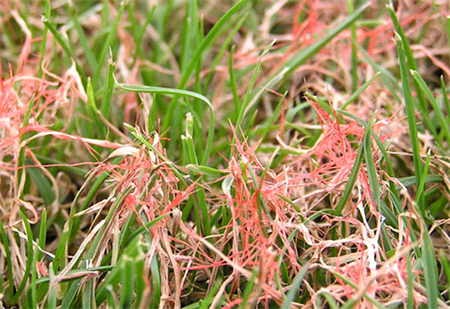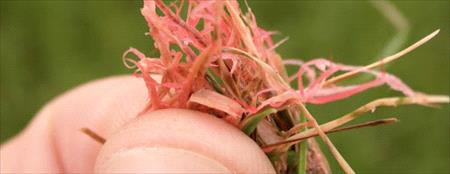Your Cart

LEARN YOUR LAWN: Red Thread
Request a Quote
What Is Red Thread?
Red Thread disease, also known as “Pink Patch,” is a common fungal disease that affects cool season turfgrasses, such as Perennial Ryegrass, Kentucky Bluegrass, and Fine Fescues. The fungus produces thread-like strands or web-like masses, which range from coral pink to deep red in colour, on the tips of the brown grass blades. The strands can protrude up to ½ inch above the blade and are easily seen, hence the name “Red Thread.”
Patches of the disease can grow up to 6 inches in diameter and may become circular or irregular in shape. As the disease progresses, the patches can enlarge, merge, and become more pronounced, leading to a thin, weak, and unattractive turf. Red Thread disease is most prevalent during periods of warm, humid weather, especially in poorly drained or nutrient-deficient soils. Red Thread disease occurs during humid periods of the spring and fall when temperatures are between 15ºC and 20ºC.
How Can I Control Red Thread In My Lawn?
Red Thread can appear overnight if the conditions are ideal, making it very difficult to control or prevent. In most cases, a change in the weather can help reduce the spread of this disease. You can also adjust your cultural practices to improve the health of the lawn and further limit the spread of the disease. However, depending on the size of the infestation and the scope of the damage, other forms of control may be necessary.
A thick, healthy, well-maintained lawn is the best line of defense. Here’s how you can adjust your beneficial cultural practices to reduce the spread of Red Thread disease:
Avoid Watering: Under normal circumstances, you should be watering each area of your lawn for 30-45 minutes, twice per week, in the early morning so the turf is dry by nightfall. However, you should avoid watering when the disease is active.
Avoid Mowing: You should avoid mowing when the disease is active. If you do have to mow, make sure your mower blade is razor sharp, so that the blade does not fray the tips of the grass, spreading the disease. Maintain a regular mowing schedule throughout the growing season. In general, you should keep your lawn between 2 ½ and 3 ½ inches high, but during the hottest weeks of summer, you may allow the grass to grow as high as 4 inches. Never remove more than ⅓ of the grass blade at each mowing.
Fertilize Regularly: Regular applications of Weed Man’s specially formulated, slow-release granular fertilizer will help provide your lawn with adequate nutrients. These applications are timed specifically to avoid over fertilizing the lawn.
Core Aeration: Aerating your lawn can improve soil drainage and help reduce the likelihood of lawn diseases. This will also alleviate soil compaction and allow water and nutrients to penetrate deeper into the soil.
Your local Weed Man professional may be able to offer other solutions and recommend the best form of treatment that is available to improve the conditions of your lawn.
 English (USA)
English (USA) Français (CANADA)
Français (CANADA)

